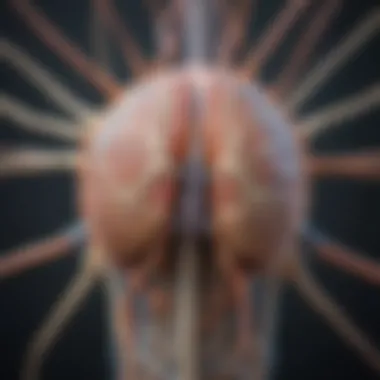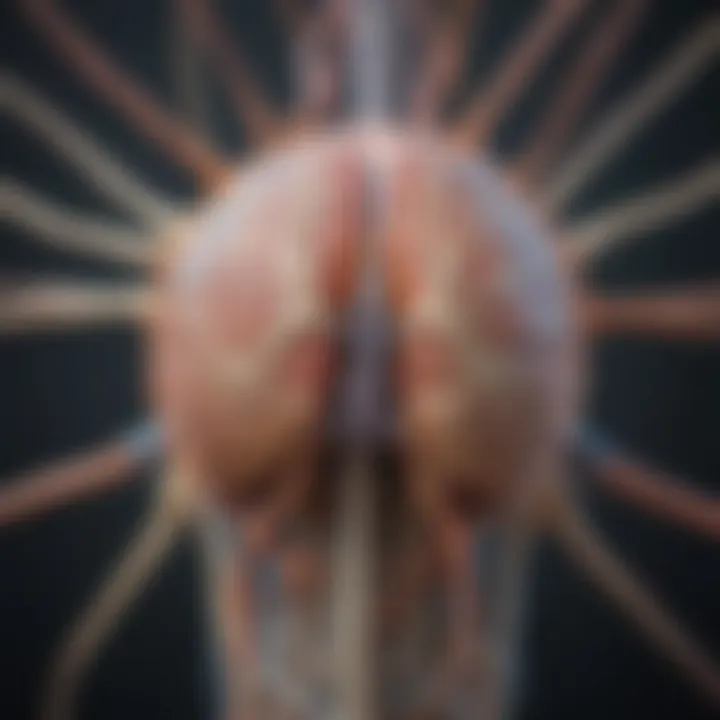Exploring the Intricacies of the Nervous System


Intro
The nervous system is a highly intricate and essential component of human biology. It governs numerous functions such as sensory perception, coordination of movements, and cognitive activities. Understanding the structure and functions of the nervous system enrich our comprehension of how organisms interact within their environments and maintain homeostasis. This article will dissect various aspects of the nervous system, providing valuable insights for students, researchers, educators, and professionals alike.
Article Overview
Summary of Key Findings
This exploration into the nervous system will unveil the complexities of both the central and peripheral nervous systems. It will detail the array of specialized cells, including neurons, which are responsible for transmitting signals, and glia, which support neuronal function and health. The article also delves into the mechanisms of neural signaling, examining how information is relayed through synapses and the interconnected pathways that facilitate communication within the body.
In understanding these processes, we uncover the underlying mechanisms that govern sensory processing, motor control, and advanced cognitive functions.
Research Objectives
The primary aim of this work is to elucidate the following key areas:
- The structural intricacies of the nervous system, distinguishing between the central and peripheral nervous systems.
- The various roles of different cell types within the nervous system.
- The physiological processes that enable sensory input and motor output.
- The correlation between neural function and common neurological disorders.
Through synthesizing existing research and practical insights, the goal is to enrich the understanding of this vital system and highlight its contributions to overall health and behavior.
Key Results and Discussions
Main Findings
The findings indicate a high degree of complexity in the interactions between different cell types within the nervous system. Neurons are not only crucial for signal transmission but also for processing information. Glial cells play indispensable roles in maintaining homeostasis and modulating neural activity. Additionally, the pathways of neural signaling show how sensory information is processed before generating a coherent response in the body.
Implications of Findings
These findings underscore the importance of a well-functioning nervous system for overall well-being. An understanding of various disorders, such as multiple sclerosis and Parkinson’s disease, informs treatment and management strategies. Furthermore, heightened awareness of the nervous system's functions can foster deeper appreciation for neurological health, leading to preventive measures that can minimize the risk of developing neural impairments.
Preface to the Nervous System
The nervous system is a fundamental aspect of human biology that orchestrates countless functions across the body. Understanding its intricacies is essential for comprehending how we interact with the environment and maintain internal stability. The nervous system enables not only physical responses but also cognitive processes that govern thoughts and emotions. By delving into this topic, we can appreciate the complexity and sophistication of the mechanisms that allow for sensory perception, movement, and decision-making.
Overview of the Nervous System
The nervous system can be divided into two primary components: the central nervous system (CNS) and the peripheral nervous system (PNS). The CNS, comprising the brain and spinal cord, serves as the control center for processing and relaying information. In contrast, the PNS connects the CNS to the rest of the body, facilitating communication between the brain and peripheral organs.
Various functions of the nervous system include regulating involuntary actions like heartbeat and digestion, as well as voluntary movements such as walking and writing.
- CNS Functions:
- PNS Functions:
- Processes sensory information
- Coordinates responses through motor output
- Transmits sensory data to the CNS
- Carries motor commands from the CNS to muscles and glands
This incredible system works in harmony to maintain homeostasis—allowing organisms to adapt to changes in their environment while ensuring that internal conditions remain within a stable range.
Historical Perspectives in Neuroscience
The journey of understanding the nervous system spans centuries, intertwining with the evolution of science itself. Early theories about how the brain and nerves worked were largely philosophical and lacked empirical evidence. Ancient civilizations, such as the Egyptians and Greeks, speculated about the brain's role but had limited anatomical knowledge.
By the 19th century, scientific advancements began to shed light on the structure and function of neurons. Pioneers like Santiago Ramón y Cajal identified that neurons were discrete cells that communicated via specialized connections called synapses. This discovery fundamentally shaped modern neuroscience and laid the groundwork for understanding various neurological disorders.
Today, the field continues to evolve, as new research techniques and technologies enable deeper insights into the workings of the nervous system. The advent of neuroimaging has provided visual representations of brain activity, enhancing our ability to explore how the nervous system correlates with behavior and cognition.
"The brain is a world comprised of a single modal logic, and understanding it requires decoding the specifics of both its structure and its functions."
This rich historical backdrop offers essential context for contemporary studies in neuroscience, emphasizing the significance of historical perspectives in shaping current understanding and research in the field.
Anatomy of the Nervous System
The anatomy of the nervous system serves as the foundational framework for understanding how this intricate system operates. It allows for the comprehension of both basic and complex processes that underlie human behavior and physiological responses. Each segment of the nervous system, whether central or peripheral, plays a unique yet interconnected role in facilitating bodily functions. Understanding this anatomy is key for students and researchers alike, offering insights into how various disorders can disrupt normal operation and contribute to disease progression.
Central Nervous System
Brain Structure and Function
The brain is often seen as the most complex organ in the body. It is responsible for processing information, regulating bodily functions, and controlling behavior. One prominent aspect of brain structure is its division into various lobes, each responsible for different functions like visual processing (occipital lobe) or problem-solving (frontal lobe). This specialization allows the brain to operate efficiently, which is advantageous for quick decision-making and adaptive behavior.
A unique feature of the brain's structure is the presence of the blood-brain barrier. This barrier is critical, as it protects the brain from toxic substances while allowing essential nutrients to pass through. However, the barrier can also pose challenges for drug delivery in medical treatments. Understanding these characteristics helps in recognizing how even minor changes in brain structure can significantly impact its functions and overall health.
Spinal Cord Organization
The spinal cord connects the brain to the rest of the body, acting as a conduit for signals traveling to and from the brain. Its organization is key, as it comprises segments corresponding to different regions of the body. Each segment gives rise to pairs of spinal nerves that innervate specific areas. This organization facilitates reflex actions, allowing for quick responses without the delay of involving the brain in every single action, which is vital for survival.
One important aspect of spinal cord organization is the differentiation between the gray matter, containing neuronal cell bodies, and the white matter, consisting of myelinated axons. This structure enhances transmission speeds for neural signals. However, injuries to the spinal cord can disrupt this organization, leading to significant functional impairments, which underscores the need for comprehensive studies in this area.
Peripheral Nervous System
Somatic Nervous System
The somatic nervous system controls voluntary movements and conveys sensory information to the central nervous system. This system is crucial for activities requiring conscious control, such as walking or writing. The primary characteristic of the somatic nervous system is its ability to coordinate fine motor skills and sensory perception effectively.
Its unique feature includes the participation of proprioceptors, which provide the brain with information about body position. This feedback loop is advantageous for making constant adjustments during movement. However, if neurotransmission is disrupted, it can lead to movement disorders, highlighting the significance of this system in overall health.
Autonomic Nervous System
The autonomic nervous system regulates involuntary autonomic bodily functions, such as heart rate and digestive processes. It plays a vital role in homeostasis. A key characteristic of the autonomic nervous system is its two subdivisions: the sympathetic and parasympathetic nervous systems. The sympathetic nervous system prepares the body for 'fight or flight' responses, while the parasympathetic system promotes 'rest and digest' activities.


One unique aspect of the autonomic nervous system is its ability to operate below the level of consciousness. This feature is beneficial as it allows the body to maintain homeostasis without requiring conscious effort. Nevertheless, imbalances in this system can lead to conditions such as anxiety or chronic stress responses, emphasizing the need for ongoing research into its components and functions.
Cell Types in the Nervous System
Understanding cell types in the nervous system is crucial for appreciating how this complex system operates. It encompasses two primary cell types: neurons and glial cells. Neurons are the main players in communication, facilitating the transmission of information across synapses. Glial cells, while often overlooked, perform critical support functions that are essential for neuronal health and function. Recognizing these different roles enhances our comprehension of how the nervous system maintains homeostasis and reacts to environmental stimuli.
Neurons: Structure and Function
Neurons are the basic building blocks of the nervous system. They are specialized cells designed to transmit information through electrical impulses. The unique structure of neurons includes dendrites, which receive signals, a cell body that processes information, and an axon that sends signals to other neurons or muscles.
Types of Neurons
The types of neurons include sensory neurons, motor neurons, and interneurons.
- Sensory neurons are critical for receiving stimuli from the external environment, such as light, sound, and pressure. They convert these stimuli into neural signals for the brain to interpret.
- Motor neurons transmit signals from the brain to muscles, facilitating movement.
- Interneurons connect neurons within the same area and are essential for reflex actions and processing information.
Each type of neuron has distinct characteristics and functions, which contribute to the overall efficiency of the nervous system. Their ability to specifically respond to various stimuli and execute appropriate responses is vital for survival.
Neuronal Communication
Neuronal communication is a sophisticated process that involves both electrical and chemical mechanisms. Action potentials travel down the axon and trigger the release of neurotransmitters at the synaptic cleft. This process is essential for transmitting signals from one neuron to another.
The rapidity and efficiency of neuronal communication enable quick responses to stimuli, a hallmark of an adaptive nervous system.
Glial Cells
Glial cells, though not as famous as neurons, are equally essential to the nervous system. They support neuronal functions and maintain homeostasis.
Functions of Glia
The primary functions of glial cells include:
- Support: Glial cells provide structural support to neurons.
- Nutrition: They supply nutrients and oxygen to neurons, which is critical for their activity and survival.
- Insulation: Some glial cells, like oligodendrocytes, wrap around axons to form myelin sheaths, which enhance signal transmission speed.
These functions highlight the importance of glial cells in maintaining the overall health of the nervous system, directly impacting neuronal performance.
Glial Cell Types
There are several types of glial cells, including astrocytes, oligodendrocytes, and microglia.
- Astrocytes help maintain the blood-brain barrier and provide metabolic support.
- Oligodendrocytes are responsible for myelination in the central nervous system.
- Microglia act as the immune cells of the central nervous system, responding to injury and disease by removing debris and pathogens.
Understanding the distinct roles and functions of these glial cell types enriches our appreciation for their contributions to the nervous system.
Glial cells are not merely passive support structures; they actively participate in neural signaling and health maintenance.
The exploration of cell types in the nervous system sheds light on the intricate interactions necessary for a fully functioning nervous system, both in health and disease.
Neural Signaling Mechanisms
The neural signaling mechanisms are vital for the communication between different parts of the nervous system. These mechanisms ensure that information is transmitted quickly and efficiently, allowing for the coordination of various functions in the body. This section focuses especially on two main components of neural signaling: action potentials and synaptic transmission.
Action Potentials
Action potentials are electrical signals that propagate along nerve cells. Essentially, they are the fundamental means of communication within the nervous system. The generation of an action potential occurs when a neuron receives a strong enough stimulus, which causes a rapid change in membrane potential. This process is significant for several reasons:
- Rapid Transmission: Action potentials can travel along axons at speeds up to 120 meters per second, ensuring that signals reach their destinations almost instantly.
- All-or-Nothing Principle: Once initiated, an action potential either happens completely or not at all, leading to reliable communication.
- Refractory Period: After an action potential, the neuron enters a refractory period during which it cannot fire again immediately. This safety mechanism prevents the signals from overlapping and ensures clear communication.
Understanding action potentials is crucial, as they form the basis for larger processes, such as muscle contraction and reflex actions.
Synaptic Transmission
Synaptic transmission involves the transfer of signals between neurons at synapses. This process is essential for almost all types of neural communication. There are two main types of synapses: chemical synapses and electrical synapses.
Chemical Synapses
Chemical synapses are the most common type of synapse in the nervous system. They function through the release of neurotransmitters, which are chemicals that transmit signals from one neuron to another. A key characteristic is that they allow for complex signaling cascades, making them integral for various cognitive functions. Here are some unique features and their implications:
- Neurotransmitter Diversity: Different neurotransmitters serve different functions, allowing precise control over various physiological processes.
- Plasticity: Chemical synapses can strengthen or weaken over time based on activity, which is important for learning and memory formation.
Overall, the ability of chemical synapses to modulate and adapt enhances the complexity of neural signaling, making them a cornerstone of neurological functions.
Electrical Synapses
Electrical synapses are less common but still play a significant role in neural signaling. Unlike chemical synapses, they allow for direct electrical communication between neurons through gap junctions. A key characteristic is their speed; electrical signals can pass through these junctions almost instantly. Key aspects include:
- Bidirectional Communication: Unlike chemical synapses, signals can travel in both directions, allowing rapid response times during reflex actions.
- Simplicity: Electrical synapses facilitate straightforward and quick signaling, which can be crucial in specific neural circuits.
However, they lack the flexibility of chemical synapses, making them generally more limited in terms of functional modulation. Understanding both types of synapses highlights the diverse ways that neurons communicate, enriching our knowledge of nervous system functioning.
Synaptic transmission is a dance of chemicals and electricity that shapes our thoughts, movements, and behaviors.
Functional Divisions of the Nervous System
The nervous system is not only complex but also incredibly organized. Understanding the functional divisions of the nervous system is crucial for grasping how it maintains balance and facilitates interactions with the external environment. This section focuses on three pivotal aspects: sensory systems, motor systems, and autonomic regulation. Each of these divisions plays a distinct yet interrelated role in our daily functions.
Sensory Systems
Sensory systems are responsible for receiving stimuli from the environment and relaying that information to the brain. They detect inputs, such as light, sound, and touch, allowing organisms to respond appropriately. The main sensory systems include the visual, auditory, olfactory, gustatory, and somatosensory paths. These systems convert different forms of energy into neural signals through specialized receptor cells.


Sensory systems serve as the gateway to perception, enabling organisms to navigate their surroundings effectively.
For example, the ability to see involves intricate processes where light hits the retina, triggering a cascade of biochemical signals leading to visual perception. Only through understanding these systems can we appreciate how they influence behavior and decision-making.
Motor Systems
Motor systems translate the neural commands generated by the brain into actions. They coordinate voluntary movements, such as walking or writing, as well as involuntary movements, like reflex actions. The motor system comprises two main components: the upper motor neurons, which originate in the brain, and the lower motor neurons, which reside in the spinal cord.
This division allows for precise control of muscle movements. For instance, when reaching for an object, the motor cortex activates specific groups of motor neurons to contract the necessary muscles while relaxing others. It ensures that movements are smooth and purposeful. The understanding of motor systems is essential in fields like rehabilitation, where regaining movement is often a primary goal for patients recovering from neurological injuries.
Autonomic Regulation
The autonomic nervous system is a subdivision of the peripheral nervous system. It regulates involuntary functions such as heart rate, digestion, and respiratory rate. This regulation occurs without conscious effort, maintaining homeostasis essential for survival. It consists of two main branches: the sympathetic and parasympathetic nervous systems.
Sympathetic Nervous System
The sympathetic nervous system prepares the body for "fight or flight" responses. When activated, it increases heart rate, dilates pupils, and redirects blood flow to essential muscles. This system is beneficial for survival in threatening situations. For example, if faced with danger, the body requires immediate, rapid responses to protect itself.
A unique feature of the sympathetic nervous system is its widespread impact on various organs, allowing for a coordinated response. However, persistent activation can lead to adverse effects like chronic stress and anxiety disorders. In this context, understanding the sympathetic nervous system’s implications is vital for managing stress-related illnesses.
Parasympathetic Nervous System
In contrast, the parasympathetic nervous system supports "rest and digest" activities. It promotes relaxation, thus slowing heart rate and stimulating digestive processes. This system allows for recovery and conservation of energy. The key characteristic of the parasympathetic system lays in its role of counterbalancing the sympathetic nervous system, promoting homeostasis after stressful situations.
A unique feature is the vagus nerve, which extensively connects to various organs, reducing overall arousal states. Understanding this division enhances our knowledge of stress management and therapies aimed at enhancing relaxation and recovery.
Higher Cognitive Functions
Higher cognitive functions are critical to the understanding of how the nervous system contributes to complex human behavior. These functions involve processes such as thinking, reasoning, and decision-making. They are not merely superior forms of basic cognitive processes but represent an intricate interplay between different regions of the brain. This section will detail two major aspects of higher cognitive functions: memory processing and emotional regulation.
Memory Processing
Memory processing encompasses various complex elements that allow humans to retain, recall, and use information from past experiences. It is essential for learning and adaptive behaviors. The ability to classify and retrieve memories is crucial for navigating daily life.
Types of Memory
There are several types of memory, each serving a unique purpose. Primarily, short-term memory and long-term memory are the most well-known categories. Short-term memory facilitates immediate recall of information, while long-term memory enables retention over extended periods.
One key characteristic of types of memory is their duration and the method of encoding. Short-term memory has a brief time frame, often lasting seconds to minutes. Long-term memory, in contrast, can last a lifetime if appropriately encoded. This is a beneficial aspect of memory that allows individuals to leverage past knowledge for current decision-making.
The unique feature of memory types is the way they interact with one another. Information from short-term memory can be transferred to long-term memory through processes like consolidation. However, memory's fragility is a disadvantage; memories can fade or become distorted over time.
Neural Basis of Memory
The neural basis of memory involves a network of brain structures, including the hippocampus, amygdala, and cortex. These areas work together to encode memories and facilitate recall. Understanding this network helps unravel how memories are formed and retrieved when needed.
A key characteristic of the neural basis of memory is synaptic plasticity, which refers to the ability of synapses to strengthen or weaken over time. This adaptability is essential for effective memory encoding and retention. In this article, it is a popular choice since it reveals the physical mechanisms behind learning and memory.
The unique feature of this neural architecture is its role in different types of memory, like declarative and procedural memory. This creates various advantages, such as specialized pathways for distinct memory types. However, the complexity of these interactions may pose challenges in exploring memory-related disorders.
Emotional Regulation
Emotional regulation refers to the ability to manage and respond to emotional experiences. This function is crucial for social interactions and mental health. Emotions can influence decision-making and behavior, thus making regulation vital for maintaining balance in life.
Role of the Limbic System
The limbic system plays a central role in emotional regulation. It consists of structures such as the amygdala and hippocampus, which are in charge of processing emotions and memories, respectively. This interaction is essential as emotions often accompany memories, influencing how information is recalled and perceived.
A key characteristic of the limbic system is its involvement in instinctual responses and complex emotional reactions. This makes it a beneficial area of focus for understanding emotional disorders. By examining the limbic system, researchers can gain insight into the neurological basis of emotions and emotional disorders.
The unique feature of this system is its capacity for both immediate emotional responses and the formation of lasting emotional memories. However, an overactive limbic system can lead to heightened anxiety and other emotional disturbances, representing a significant disadvantage.
Neurotransmitters and Emotions
Neurotransmitters play a crucial role in how emotions are experienced and regulated. Chemicals such as dopamine and serotonin greatly influence mood, motivation, and overall mental health. Understanding these mechanisms helps clarify the biological basis of emotions and their regulation.
The key characteristic of neurotransmitters in emotional regulation is their ability to alter neural communication. This is beneficial when addressing emotional disorders as it opens pathways for pharmacological treatments.
The unique feature of neurotransmitter systems lies in their dynamic changes according to environmental factors and individual physiology. This adaptability offers advantages for therapeutic interventions. However, the complexity of neurotransmitter interactions can complicate treatment approaches for emotional disorders.
Understanding higher cognitive functions such as memory and emotional regulation is critical for unraveling the complexities of the nervous system and how it influences human behavior.
Pathophysiology of the Nervous System
The pathophysiology of the nervous system plays a crucial role in understanding how various conditions can affect its function. This area emphasizes the mechanisms and effects of disorders that impair the nervous system, which can lead to significant changes in behavior, movement, and cognition. Understanding these aspects helps in identifying potential therapeutic avenues and improving patient outcomes. This section will dive into two primary categories: neurological disorders and mental health disorders, addressing how these conditions impact the overall function of the nervous system.
Neurological Disorders
Neurodegenerative Diseases
Neurodegenerative diseases are a group of disorders characterized by progressive degeneration of the structure and function of the nervous system. Conditions such as Alzheimer's disease, Parkinson's disease, and Amyotrophic Lateral Sclerosis (ALS) fall within this category. The key characteristic of neurodegenerative diseases is their gradual onset and cumulative impact on the individual's abilities. They are valuable to this article as they highlight the vulnerabilities of the nervous system as it ages and undergoes changes.
A unique feature of these diseases is the accumulation of misfolded proteins that interfere with neuronal function. The advantages of focusing on neurodegenerative diseases include a better understanding of risk factors and potential treatment options. However, the disadvantages may lie in the limited effective therapies and the uncertain prognosis, which can lead to emotional and financial stress for families.
Traumatic Injuries
Traumatic injuries to the nervous system can result from accidents, falls, or violence, producing immediate and long-lasting effects. These injuries often affect the spinal cord or brain, leading to conditions such as paralysis, tremors, or impaired cognitive abilities. The key characteristic of traumatic injuries is their sudden onset, which starkly contrasts with the gradual progression seen in neurodegenerative diseases. This makes the topic particularly compelling as acute management becomes crucial immediately after injury.
A unique feature of traumatic injuries is the variability in outcomes; recovery can range from complete rehabilitation to permanent disability. The advantages of exploring this area include insights into rehabilitation techniques and prevention strategies. On the downside, the unpredictability of recovery can be distressing for patients and families, complicating the path forward.


Mental Health Disorders
Anxiety Disorders
Anxiety disorders encompass a range of conditions characterized by excessive worry, fear, and apprehension. These can manifest as generalized anxiety disorder, specific phobias, panic disorder, and social anxiety disorder. The core characteristic of anxiety disorders is their impact on daily functioning, often leading to significant emotional distress. Studying anxiety disorders is beneficial because they elucidate the connection between emotional states and neuronal function, offering insights into the nervous system's role in our mental well-being.
One unique aspect is the involvement of neurotransmitters like serotonin and dopamine, which play a significant role in mood regulation. Understanding these mechanisms allows for the development of targeted therapies. However, treatment efficacy can vary widely among individuals, making it challenging to find the optimal approach for each patient.
Depression
Depression is another leading mental health disorder that affects millions worldwide, characterized by persistent feelings of sadness and loss of interest in activities. The key characteristic of depression is its profound impact on both cognitive and emotional processes, influencing everything from decision-making to sleep. Its examination in this article is relevant due to the increasing prevalence of depression and its significant public health implications.
A unique feature of depression involves neurobiological changes, such as alterations in brain structure and function. This highlights the importance of early diagnosis and intervention. While there are effective treatments available, stigma surrounding mental health can often prevent individuals from seeking help, complicating recovery.
Understanding the pathophysiology of the nervous system is essential for addressing various disorders and significantly contributes to the advancement of neuroscience.
Advancements in Neuroscience Research
Advancements in neurocience research are vital for understanding the complex functions and disorders of the nervous system. This rapidly evolving field is crucial for developing effective treatments and improving health outcomes. Research findings can lead to new therapies that target neurological and psychiatric conditions, enhancing our comprehension of how the brain and nervous system operate.
Current Research Trends
Currently, neuroscience research is experiencing several notable trends. One significant focus is the investigation of brain plasticity. Researchers are examining how the brain can adapt and reorganize in response to experiences. Another area is the study of the gut-brain axis. This involves looking into how gut microbiota affect brain function and mental health, suggesting a deeper connection between the two systems than previously acknowledged.
Besides these, neuroinflammation has gained attention, linking inflammatory processes with neurodegenerative diseases. Lastly, social neuroscience is emerging, exploring how social environments impact brain functions and behavior.
Technological Innovations
Technological innovations significantly facilitate advancements in neuroscience research. These breakthroughs provide new tools for studying the nervous system in more detail than ever before.
Neuroimaging Techniques
Neuroimaging techniques have transformed our understanding of the brain. Methods such as functional magnetic resonance imaging (fMRI) allow scientists to visualize brain activity in real time. The key characteristic of these techniques is their ability to map brain regions while subjects engage in various tasks.
This makes neuroimaging a popular choice for understanding brain function. By revealing dynamic changes in blood flow, researchers can ascertain which parts of the brain are active during specific mental processes.
However, these techniques have their unique features and limitations. For example, fMRI offers excellent spatial resolution but has relatively poor temporal resolution when compared to other methods. This can be a disadvantage when studying rapid brain activities.
Neuroprosthetics
Neuroprosthetics represent a groundbreaking area in neuroscience. This field focuses on developing devices that can restore, replace, or enhance nervous system function. The key feature of neuroprosthetics is their ability to interface directly with the nervous system, which enables control over prosthetic limbs or even communication devices.
These innovations are beneficial for people who have lost motor function or suffered brain injuries. They can significantly enhance quality of life by providing new ways to interact with the environment.
While promising, neuroprosthetics also pose challenges. One issue is the complexity of the integration between human neural systems and artificial devices. Ensuring long-term efficacy and minimizing rejection or malfunction are ongoing areas of research.
"The progress in neuroscience research not only provides insights into health but also paves the way for future technologies that can change lives."
The Future of Neuroscience
The future of neuroscience presents a significant frontier in understanding the complexities of the nervous system and its numerous functions. As advancements continue, researchers seek to unravel mysteries about brain operations, promote health through innovative therapies, and address ethical dilemmas while exploring the potentials of the human mind. This section will focus on two critical elements: ethical considerations and potential therapies that could reshape neuroscience.
Ethical Considerations
As neuroscience grows, ethical implications become more prominent. The progress in technology poses questions regarding the boundaries of experimentation and manipulation of the nervous system. Issues such as brain-computer interfaces, neuroenhancement, and genetic modifications prompt debates about individual rights and societal impacts.
- Confidentiality of Neural Data: With advancements in neuroimaging and data collection, the privacy of personal neural data is at risk. Establishing robust guidelines is essential to protect information that can reveal thoughts or behavioral patterns.
- Informed Consent: In clinical research, ensuring that participants fully understand the implications of their involvement becomes vital. Many procedures require complex explanations, which can hinder true informed consent.
- Dual-Use Research: Some discoveries may have beneficial outcomes but also potential for misuse, such as enhancing military capabilities. Researchers must recognize the moral responsibility attached to their findings.
“Ethics must guide the advancements of neuroscience, ensuring that progress benefits society while safeguarding individual rights.”
The future of neuroscience demands ongoing dialogue about these ethical considerations to balance innovation and responsibility.
Potential Therapies
As researchers pursue new methods to address neurological disorders and enhance cognitive functions, two prominent areas show great promise: gene therapy and stem cell research. These therapies offer unique solutions but also come with their own sets of challenges.
Gene Therapy
Gene therapy focuses on correcting genetic abnormalities causing disorders. Its approach utilizes vector systems to deliver functional genes into patients' cells, aiming to alleviate symptoms or cure diseases. This method is particularly beneficial in genetic neurological conditions, such as spinal muscular atrophy.
- Key Characteristic: One of the main features of gene therapy is its ability to target the root cause of diseases at the genetic level.
- Advantages: Gene therapy is considered a preferred choice because of its precision in addressing specific conditions rather than treating symptoms alone. It has the potential to provide long-term solutions, possibly moving patients away from lifelong treatments.
- Disadvantages: However, risks such as immune responses and unexpected genetic alterations can arise, making safety a concern that needs thorough exploration.
Stem Cell Research
Stem cell research looks into using stem cells to regenerate or repair damaged neural tissues. This offers hope for disorders like multiple sclerosis and Parkinson's disease. The appeal of stem cells lies in their ability to differentiate into various cell types, potentially restoring function.
- Key Characteristic: A distinctive aspect of stem cell research is its ability to replenish lost cells, providing possibilities for reversing damage.
- Advantages: This research is seen as beneficial for its regenerative potential. If successful, stem cell therapies could lead to significant advancements in treating long-term neurological conditions.
- Disadvantages: Ethical issues concerning the source of stem cells, particularly embryonic stem cells, present hurdles that researchers must navigate, along with concerns around the treatment's efficacy and safety.
In summary, the future of neuroscience is rich with potential. However, as new therapies are developed, ongoing discussions about ethical ramifications will remain crucial. By acknowledging these factors, we can pave a path towards a more informed and responsible future in neuroscience.
Culmination
The conclusion serves as an essential component in this exploration of the nervous system. In synthesizing the various themes discussed throughout the article, it emphasizes the interconnectedness of the nervous system's structure, function, and its essential roles in maintaining homeostasis. This journey through the complexities of the nervous system provides a deeper understanding of how it influences both cognitive and physical aspects of human life.
Summary of Key Points
In summation, several key points emerge:
- The nervous system, divided into central and peripheral segments, is crucial for processing sensory information and coordinating responses.
- Neurons and glial cells are the foundational units that facilitate communication across the system, demonstrating the complexity of neuronal signaling.
- Disorders affecting the nervous system range from neurodegenerative diseases, like Alzheimer's, to mental health issues, which underline the fragility and significance of this intricate system.
- Emerging research highlights advancements in neuroimaging and neuroprosthetics, showcasing innovation and potential in neuroscience.
Implications for Future Research
The future of neuroscience is rich with possibilities. Understanding the nervous system is not merely an academic pursuit but holds practical implications for improving health outcomes. The exploration of gene therapy and stem cell research offers promising avenues for alleviating the impact of neurological disorders. Furthermore, continuous advancements in technology will enhance our ability to study and manipulate neural processes. This evolving field requires ongoing collaboration among researchers, educators, and practitioners to translate findings into therapeutic strategies.
"The future of research in neuroscience holds significant implications for understanding and treating complex disorders."
In contemplating the nervous system’s role in health and disease, further investigation promises to bridge knowledge gaps, driving forward our capacity to address both clinical and societal challenges linked to neural health.







